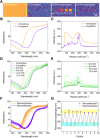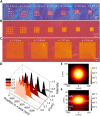Rewritable color nanoprints in antimony trisulfide films
- PMID: 33328223
- PMCID: PMC7744068
- DOI: 10.1126/sciadv.abb7171
Rewritable color nanoprints in antimony trisulfide films
Abstract
Materials that exhibit large and rapid switching of their optical properties in the visible spectrum hold the key to color-changing devices. Antimony trisulfide (Sb2S3) is a chalcogenide material that exhibits large refractive index changes of ~1 between crystalline and amorphous states. However, little is known about its ability to endure multiple switching cycles, its capacity for recording high-resolution patterns, nor the optical properties of the crystallized state. Unexpectedly, we show that crystalline Sb2S3 films that are just 20 nm thick can produce substantial birefringent phase retardation. We also report a high-speed rewritable patterning approach at subdiffraction resolutions (>40,000 dpi) using 780-nm femtosecond laser pulses. Partial reamorphization is demonstrated and then used to write and erase multiple microscale color images with a wide range of colors over a ~120-nm band in the visible spectrum. These solid-state, rapid-switching, and ultrahigh-resolution color-changing devices could find applications in nonvolatile ultrathin displays.
Copyright © 2020 The Authors, some rights reserved; exclusive licensee American Association for the Advancement of Science. No claim to original U.S. Government Works. Distributed under a Creative Commons Attribution NonCommercial License 4.0 (CC BY-NC).
Figures






References
-
- Zhu X., Vannahme C., Højlund-Nielsen E., Mortensen N. A., Kristensen A., Plasmonic colour laser printing. Nat. Nanotechnol. 11, 325–329 (2016). - PubMed
-
- Kumar K., Duan H., Hegde R. S., Koh S. C. W., Wei J. N., Yang J. K. W., Printing colour at the optical diffraction limit. Nat. Nanotechnol. 7, 557–561 (2012). - PubMed
-
- Y. Jin, I. Qamar, M. Wessely, A. Adhikari, K. Bulovic, P. Punpongsanon, S. Mueller, Photo-chromeleon: Re-programmable multi-color textures using photochromic dyes, in Proceedings of the 32nd Annual ACM Symposium on User Interface Software and Technology (ACM, 2019), pp. 701–712.
-
- Tan S. J., Zhang L., Zhu D., Goh X. M., Wang Y. M., Kumar K., Qiu C.-W., Yang J. K. W., Plasmonic color palettes for photorealistic printing with aluminum nanostructures. Nano Lett. 14, 4023–4029 (2014). - PubMed
-
- Liu H., Xu J., Wang H., Liu Y., Ruan Q., Wu Y., Liu X., Yang J. K. W., Tunable resonator-upconverted emission (TRUE) color printing and applications in optical security. Adv. Mater. 31, 1807900 (2019). - PubMed
LinkOut - more resources
Full Text Sources
Other Literature Sources

